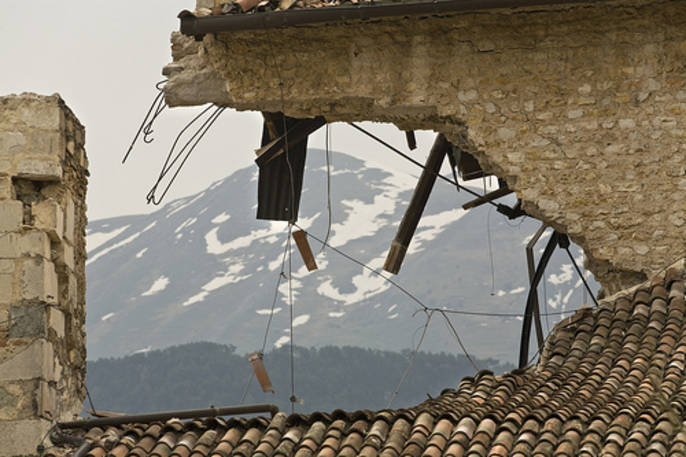


I returned on the day that is a time for picnics and outdoor excursions throughout Italy. There was no air of celebration in Abruzzo this Easter Monday, the day before the first anniversary of the earthquake that destroyed the heart of the capital city’s historic center and buried so many human lives.
I returned on a windy, rainy day. My car was acting up, and with difficulty it climbed the serpentine road leading from the coast on the Navelli plateau into the L’Aquila basin. I did not have permission to enter the red zone which was closed to traffic, but there was no need to. My work took me through all the roads that quickly collapsed and claimed many lives, and there was no need for me to revisit those crossroads to descend again into the inner anguish – the anguish that does not dissolve as you walk on the pavement of the old town center. Today is a sad day and one can read it on the faces of the residents of L’Aquila and Abruzzo.
One year is enough to shake the dust from the rubble but not enough to remove the boulder from their hearts of despair. It is only the beginning of a bureaucratic ordeal that will last ten years at least. One year later, I have amassed so many feelings, I harbor memories and anger, I have experienced the slow return to forced normalcy, the melancholy enthusiasm of those who are required to start from scratch.
I lived between the curtains of Nuova Acropoli’s volunteers, and along with my Italian-American friend Luciano Borsari, I walked through the prohibited debris to collect fragments of stories, fragments that belong to the life I lived on the streets of L’Aquila. It will not be easy to get out from under the instability.
There are too many deep wounds inflicted on this city, on its agorà, its town center. It is a city that has lost its central meeting place. Built by Frederick II, L’Aquila has a particular geography. Its surrounding hamlets are twenty miles from the center and represent the original nucleus of those villages that contributed to the construction of the medieval town. The central square, then, represents the true center of gravity of a city that is dispersed in a circle around the valley; it was the meeting place for citizens who otherwise lived too far from the administrative center.
It’s a sad city that will slowly be reborn in the coming months. Its soul has been buried along with the 308 victims of the earthquake. It’s an angry city that will be reborn in the coming years. There are those modern buildings that collapsed like cardboard, the ones that crumbled while the eighteenth century buildings and the houses from the Fascist era withstood the impact. Even ordinary homes held up well against the terrible jolt that unexpectedly arrived during the night. But there can be no peace for those who, for many years to come, will still want an explanation as to why the dormitory was full of construction flaws while recalling its collapse with horror.
It’s a time of celebration. Tonight is a night for prayers and candles. And I’ve returned to my city on the coast carrying the weight of my conscience. But what about the unscrupulous builders who used flimsy iron foundations and the lowest quality concrete? And those who smiled, mocking the many appeals for more stringent building codes?
The city has chosen to commemorate the event with a gathering that will begin at 9:30 p.m. with four runners originating from the cardinal points at the seismic crater. Afterwards, there will be a candlelight procession starting in each of the four neighborhoods that converge at the Fontana Luminosa, advancing to the areas of the red zone open to the public, and finally arriving in Piazza Duomo at the fateful hour of 3:32 a.m. Pescara has chosen to toll the church bells at the same time to remember the victims of the tragedy.
At 4:00 a.m. in Onna, the German Ambassador to Italy Michael Steiner will lay the first stone at the Casa Onna civic center on the site of the town hall that was destroyed by the earthquake. Other events will also take place on April 6 include the laying of a wreath in the Coppito barracks, the creation of a human wreath in the accessible portion of the city center and the release of balloons, while on Facebook more than 19,000 subscribers have signed up for “A Candle for L’Aquila” to participate in preserving the memory of the victims.
“It was not a year that went by in vain,” explained the Head of Civil Protection, Guido Bertolaso. “What was achieved in L’Aquila is very important, and the fact that we still receive calls from all over the world is another example of the support and consideration we have on an international level. No one was abandoned and left alone. It seems to me that the state, the country has responded with solidarity, strength, intervention, as well as composure. Over the past 12 months much has been done: the school year has begun again, the university was reopened, and we had the opportunity to provide comfortable homes to tens of thousands of people rather than put them in trailers without knowing exactly what would their fates or futures would be. Reconstruction should begin.
We have said that this should be the responsibility of local authorities; we have laid the path that must be followed for the reconstruction that we all want to see and that we all hope will be implemented soon.
The hope is that it will be a road paved with work completed according to the letter of the law.
Source URL: http://newsite.iitaly.org/magazine/focus/facts-stories/article/earthquake-one-year-later-332-numbers-remember
Links
[1] http://newsite.iitaly.org/files/13860collemaggio1270506612jpg